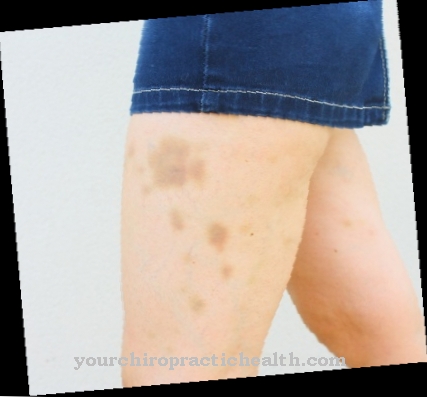Arm pain can have various causes. Depending on the underlying disease, the symptoms are accompanied by other symptoms. The course of the disease and treatment also depend on what is causing the arm pain.
What is arm pain?

Arm pain is pain in the upper limbs. The pain stimulus arises when tissue in the arm is damaged or insufficiently supplied with blood. Ascending nerve tracts report to the brain that something is wrong.
The person then perceives this as arm pain. The damage can be directly in the affected limb or a bit away from it. One then speaks of a pain that radiates into the arm. In medicine, a distinction is made between arm pain that occurs at rest and those that arise when moving the shoulder, elbow or wrist.
There is bone pain and soft tissue pain in muscles and connective tissues. Arm pain can also affect the blood vessels.
causes
Injuries are a common cause of arm pain. These can be broken bones, open wounds, bruises, pulled muscles or dislocations. A herniated disc can be responsible for pain radiating to the arm.
But joint diseases also cause arm pain. A joint can be overstrained for a short time or, as with osteoarthritis, damaged or worn out over a long period of time. An inflammation in the joint itself or in the surrounding bursa can cause arm pain.
But not only the joints can become inflamed, muscles and tendons too.A very serious cause of severe arm pain is bone metastases from cancer. But the occlusion of an artery or a thrombosis in an arm vein can also lead to severe arm pain.
Severe pain that radiates into the arm can also be a sign of a heart attack. In diabetics, the small blood vessels and nerves throughout the body are often damaged. This can cause arm pain, among other things.
You can find your medication here
➔ Medicines for painDiseases with this symptom
- Broken bone
- Heart attack
- Elbow dislocation (elbow dislocation)
- Shoulder arm syndrome
- arthrosis
- disc prolapse
- Tennis elbow
- Biceps tendon tear
- Inflammation of the joints (arthritis)
- Tendinitis
- Chassaignac palsy
- Broken elbow
- Broken wrist
- Inflammation of the bursitis (bursitis)
- sprain
course
Arm pain caused by acute illness, an accident, or overexertion usually has a good chance of recovery. Inflammation also usually heals without any problems with the right treatment.
However, if the person affected has other diseases such as diabetes mellitus or a weakened immune system, the healing process can be delayed. It is possible that an acute inflammation will develop into a chronic one and that the arm pain will persist, sometimes stronger, sometimes weaker.
Arm pain caused by a blockage in the arteries or veins usually disappears when the obstruction is removed. However, it can also lead to long-term damage to the blood vessels, which continues to cause arm pain.
Complications
The cause of arm pain can be very different. So it has to be determined where the arm pain actually comes from. Pain in the arm often indicates that the tissue is not getting enough blood or that a nerve is trapped.
The damage can lie directly in the arm, but it can also be further away, one then speaks of pain that radiates into the arm. It also depends on whether the arm also hurts during the rest phase or whether it only shows the symptoms when under stress. If the cause is a fracture or a sprain, diagnosis is relatively easy. However, there may also be a herniated disc, and the pain radiates into the arm. Joint pain can also be responsible, arm pain is not uncommon with osteoarthritis or rheumatism. Perhaps there is also inflammation in the joint, but muscles and tendons can also become inflamed.
Severe arm pain in cancer can also indicate metastases in the bones, and arm pain can also be caused by a heart attack.
If the arm pain is caused by an accident or a short-term overload, it is easy to cure. Even with inflammation, the right treatment can quickly resolve arm pain. However, if the patient has other illnesses, the healing process can take a long time, some arm pain persists, sometimes stronger and sometimes weaker. Treatment always depends on the cause, but in diabetes or cancer, the underlying disease must be treated. It is only important that the diagnosis is made quickly so that acute arm pain does not turn into a chronic disease.
When should you go to the doctor?
Arm pain is one of the types of pain that has many different causes. The pain can affect the entire arm or parts of it: the upper arm, forearm, and elbow. In the case of arm pain caused by overexertion, a visit to the doctor is often unnecessary, as the pain usually disappears after a few days. Even lighter strains - for example due to clumsy movement or during sport - do not always require medical treatment. Otherwise, if you have arm pain, it is advisable to see a doctor, preferably first at your family doctor
Well-known triggers for arm pain are:
- open wounds
- Inflammation
- Broken bones
- Bruises
- Pulled muscles
- Contortions
- arthrosis
- Carpal tunnel syndrome
Arm pain can also be caused by the radiation of pain from another location in the body, for example a herniated disc or a heart attack. Vascular occlusions in the arm can also lead to severe pain. This often also affects diabetics, in whom even small blood vessels and the nerve tracts in the entire body, including the arms, are damaged in the advanced stage. It becomes clear, therefore, how important a thorough investigation of the cause is for most arm pain.
Depending on the cause, the following specialists can be considered for the treatment of arm pain: internists, orthopedists, cardiologists, neurologists, gastroenterologists and angiologists.
Doctors & therapists in your area
Treatment & Therapy
Treatment for arm pain depends on the cause. Broken bones can be operated on, splinted or in a cast. Dislocated joints are corrected again after pain medication. Occlusion of a vein or artery can be treated with surgery or medication, depending on where the obstruction is and how severe the damage is.
If there is inflammation, the doctor may prescribe antibiotics and anti-inflammatory drugs. Depending on the severity of the inflammation, administration as an infusion, syringe, tablet or juice is indicated. Naturopathy also knows various ways of stimulating the patient's self-healing powers and supporting medical measures with compresses, pads, teas, homeopathic medication or acupuncture.
If cancer, diabetes mellitus or other diseases that affect the entire body are the cause of arm pain, these underlying diseases must be treated. It is generally important that professional treatment is carried out as quickly and specifically as possible so that an acute illness does not become a chronic one and the arm pain therefore lasts for a long time.
Outlook & forecast
Arm pain can occur for many different reasons. The success of a treatment therefore depends heavily on the cause of the arm pain. If the arm pain occurs after an accident or after a blow on the arm, a doctor must be consulted urgently. These can be fractures, breaks or a compression in the arm, which must definitely be treated by a doctor. Typically, arm pain treatment is effective and does not lead to further medical complications.
Arm pain also occurs when the arm is overstrained and is therefore a common symptom. In this case, the arm needs relaxation and should no longer be exerted. Continued exertion can cause inflammation and tears in the muscles.
Only in rare cases is an operation necessary to relieve the arm pain. Physiotherapy or heat therapy often helps. In the event of fractures or other severe injuries, orthopedic aids are used to make everyday life easier for the patient.
In the case of overexertion and sore muscles, the arm pain usually disappears within a few days and does not require further treatment by a doctor.
You can find your medication here
➔ Medicines for painprevention
In order to prevent arm pain, one should avoid the constant uniform strain on one arm during sport or at work. Regular exercise keeps the joints healthy and ensures that muscles and tendons remain elastic. The bones also need movement so that they are well supplied with blood and arm pain cannot arise. A healthy diet prevents metabolic diseases such as diabetes mellitus.
You can do that yourself
People who suffer from arm pain can sometimes treat them themselves. It is important that regular breaks are taken and relaxation exercises are carried out. To support this, putting on a splint and applying pain relieving ointments can help. These should contain either ibuprofen or salicylic acid. After the arm pain has subsided, we recommend using heat, plasters or baths.
In the self-treatment of arm pain, compresses with cool quark are effective. The quark is first applied to a thin towel. Then those affected put the poultice on the painful area. The cooling reduces arm pain. As soon as the envelope is warm, the affected person can put on a new one.
Alternatively, ice packs have proven effective for pain relief and cooling. However, these should only be placed on the painful region for a short time. To avoid hypothermia, those affected should place a cloth between the arm and the ice pack. It is also recommended to rub in St. John's wort oil and marigold ointment. These have anti-inflammatory and analgesic effects.
Irradiation of arm pain with red light is sometimes useful. However, those affected should ask their family doctor or an orthopedic surgeon beforehand about the duration of the red light radiation. Arm pain can also be relieved by holding their arm under cool tap water for two minutes. Then it should dry in the fresh air and be kept quiet for 30 minutes.
























.jpg)



